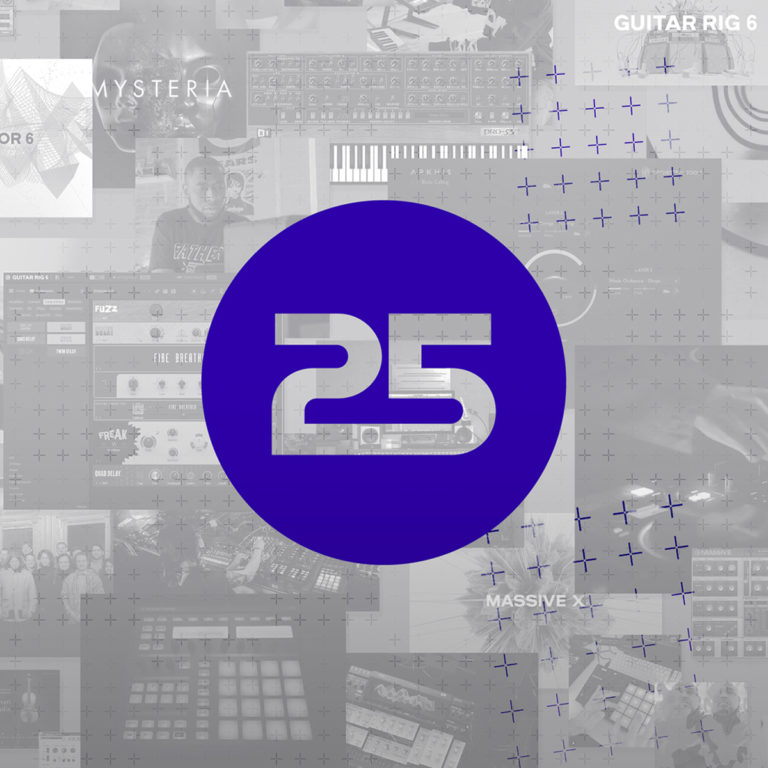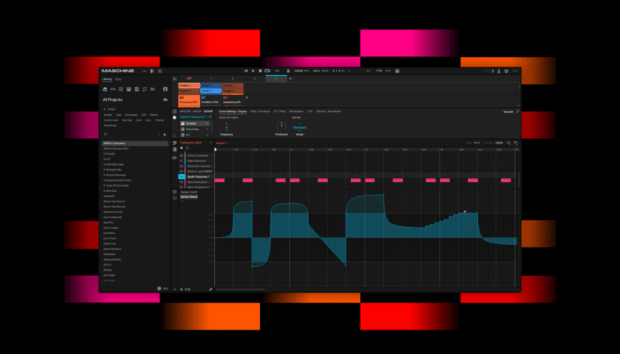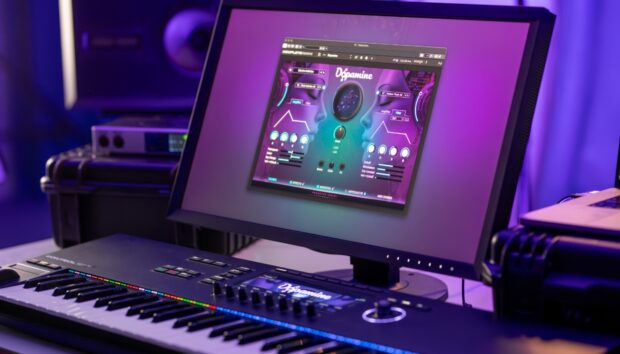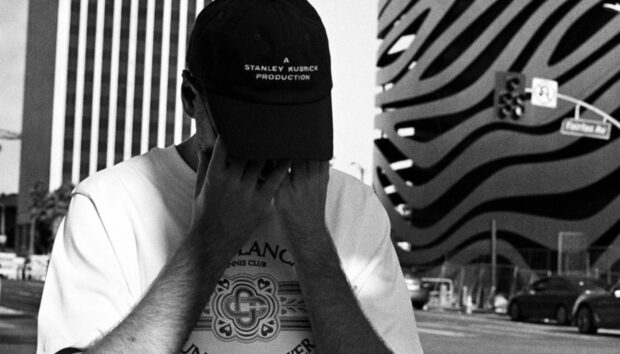It would have been impossible to predict, back in 1996, that Stephan Schmitt’s software modular GENERATOR would kick off 25 years of innovative synths, effects, sampling platforms, hardware, and more – let alone the billions of hours of incredible music that the community would use them for. Today, we’re proud of the fact that countless Billboard number ones, blockbuster soundtracks, and stadium-filling live shows have all been made possible (or at least helped along) by NI tools.
This anniversary seems the perfect moment to take a look back and count out 25 of those NI-made musical moments that we’ve learned about from across the years. So read on to discover some important, influential, and just plain interesting tracks and albums, and learn a little about the NI sounds that helped make them possible.
And we’re always curious to discover what you’re creating with our NI products – so don’t forget to share your own creations with us on social, using #madewithNI or #NI25.
1999: The Fragile – Nine Inch Nails
Nine Inch Nails’ Trent Reznor was an early adopter of NI equipment. A year after the 1996 release of GENERATOR – the predecessor to REAKTOR – Reznor was getting a PC hooked up in his studio just to try it out. “It seemed like the most amazing tool that we’d ever come across,” he recalled in 2005. “It made a lot of the things that we were messing around with at the time seem like they were going to be obsolete.”
The result of those sessions was 1999’s The Fragile, one of NIN’s most exploratory and well-regarded albums, in which electronic sounds softened and deepened the distorted textures of the group’s earlier work. Reznor would continue to use NI equipment in his ever-evolving production process, including treating REAKTOR as a virtual guitar pedal board, for a “science fiction” take on classic distortion effects.
1999: Gobi. The Desert – Monolake
Today, Monolake is the solo vehicle of Berlin-based producer and software developer Robert Henke. But back in the late 90s it still included soon-to-be Ableton founder Gerhard Behles.
The 34-minute epic “Gobi. The Desert,” first released in 1999, is one of the last Monolake tracks to feature Behles, who at the time was working on REAKTOR for NI – a beta version of which was used throughout the track. The original material that was slowed down and turned to grains for “Gobi” later resurfaced in a drum & bass-influenced configuration as “Polaroid”.
2000: Kid A – Radiohead
The openness and endless possibilities of REAKTOR caught the imaginations of many cutting-edge producers at the turn of the millennium. Suddenly, instead of waiting for manufacturers to surprise you with new instruments, you could roll up your sleeves and build them yourself. As such, the tool often pops up in the era’s more exploratory records.
One such record is Radiohead’s Kid A. Signalling the band’s transformation from guitar-based innovators to studio visionaries, the album draws heavily on electronic influences – not least the IDM of Warp records. The band’s producer, Nigel Godrich, has since confirmed that REAKTOR played a big role in this process – leading to a record that Pitchfork readers recently voted the single greatest album of the past 25 years.
2001: Exciter – Depeche Mode
New wave legends Depeche Mode were always keen on making the most of the studio tools available to them – and this was still very true as the 90s drew to a close and they began work on their exploratory tenth album.
With its unapologetically digital soundscapes, Exciter was the first time the band had fully exploited the emerging potential of software instruments and effects. Guitar/keyboard player Martin Gore and the album’s producer, the late Mark Bell, have both singled out REAKTOR as an important part of Exciter’s sound. The then-just-released ABSYNTH is also known to have featured in places.
2003: Blemish – David Sylvian
Cult favorite David Sylvian’s self-produced Blemish marked a sonic turning point. In 2003, following the end of both a record deal and a marriage, the album saw the former Japan frontman document his situation against a newfound backdrop of atmospheric electronics – which is why ambient producer and guitarist Fennesz made an ideal collaborator.
All of the synth and guitar sounds heard on wistful album closer “A Fire In The Forest” are based on REAKTOR patches, performed by Fennesz. The Austrian producer is a long-time fan of the platform, the free offerings of the REAKTOR User Library in particular.
2004: The Blue Notebooks – Max Richter
German-British composer Max Richter is one of a small handful of contemporary classical artist to have successfully broken into the mainstream consciousness. One of the keys to his success is surely his willingness to embrace electronics in his music, with 2004’s The Blue Notebooks a standout example of his fusion of tradition with technology.
“I went through a whole Reaktor craze,” he told NI in a previous interview. “The Blue Notebooks and Songs from Before were my Reaktor Ensemble building high-point. For me it’s always been a bit like an accidental ideas generator.”
2007: The Salmon Dance – The Chemical Brothers
MASSIVE, NI’s landmark wavetable synth, was released in 2007. With its clean, controlled, and – well – massive sound, it would pop up continuously in the charts throughout the next decade.
The Chemical Brothers – themselves known for making 90s electronic music stadium-sized – got started with it early. “Salmon Dance”, a single from their 2007 album We Are The Night, is rumored to make use of a MASSIVE preset named “Big Deeper”. It’s a key component in a kooky instrumental which – along with Fatlip’s oddball vocal and that unforgettably weird video – makes for one of the duo’s last enduring hits.
2008: Hard Candy – Madonna
By 2008, Timbaland was looking back on a decade in which he’d ascended from unknown grafter to one of the most influential producers on the planet. He was also, like any good producer, looking around for inspiration. One anecdote has him dropping by the NI offices in Berlin and saying, “Show me something new!”.
He was certainly using NI gear when working on Madonna’s Hard Candy. Featuring production and vocals from Timbaland and fellow era-definers Justin Timberlake and The Neptunes, the album was Madonna’s attempt to catch the flavour of the moment. “I don’t like to repeat myself,” she said at the time, “And I was sitting around thinking, ‘What music do I love right now?”
2009: Bleeding Love – Leona Lewis
Full of heart and melodrama, Leona Lewis’s”Bleeding Love” is one of the most memorable pop ballads of its era. It updates the torch song format for the late ‘00s: the weighty backbeat, full-throated vocal and simmering organ accompaniment are all present and correct, but they’ve the uncanny crispness and precision of the fully digital era.
The song has NI to thank for its snare, crunchy but almost clinically exact. It points to an NI specialty: organic sounds, with the added control and cleanness of digital production. Perfect for the producer who wants the best of both worlds.
2010: Abstract Lover – Squarepusher
British producers Tom Jenkinson, aka Squarepusher is one of a wave of Warp artist who changed the direction of electronic throughout the ‘90s. He’s perhaps best known for his combination of virtuosic bass-guitar playing and glitched-out, intricately programmed electronics – both of which feature on 2010’s Abstract Love.
While his exact methods are rarely made public, Jenkinson is known to be a keen REAKTOR user. In this track, he tells Sound on Sound, the bass is processed via a frequency divider and distortion patch he created using the platform.
2012: Money Trees – Kendrick Lamar
Kendrick Lamar’s Good Kid, M.A.A.d City is often praised for its lyrical and conceptual strengths. It was Kendrick’s storytelling, after all, which would bag him a Pulitzer prize for DAMN. half a decade later. But rock solid production also contributes to the album’s power.
In the case of “Money Tree”, it’s the deft fingers of DJ Dahi on the buttons. He draws on a couple of NI tools. The bass sounds like the “Caffeteria” preset from RAZOR: it does what an 808 would do, but with a characterful twist. The percussion, meanwhile, uses KONTAKT’s WEST AFRICA collection to give the subtlest flavour to an otherwise sparse beat.
2012: Boyfriend – Justin Bieber
“Butterfly Stance” was a preset for NI’s MASSIVE: a crisp, atmospheric keys sound which cuts neatly through most mixes. It’s the kind of handy patch which you drop into a track in the heat of the moment and never feel the need to change. (MASSIVE had many of these).
It’s easy to imagine this happening during the making of Justin Bieber’s “Boyfriend”, a 2012 overhaul of his nice-boy image via the raunchy club sounds of the early 2000s. The preset plays a subtle but crucial supporting role in the choruses. It features in a rash of other tracks from this time too, including Nas’s “Hero,” Afrojack’s “Freedom,” and, as we’ll see later, Migos’ Autopilot.
2013: Garbage – Tyler, The Creator
Tyler, The Creator’s provocative lyrics can sometimes distract from the brilliance of his beats. His gloomy early era, in particular, brought a bevy of vivid new sounds and textures into hip-hop’s vocabulary.
Going on his synth work, it seems he was a heavy Reason user at the time; avid sound spotters have also flagged ABSYNTH presets and BATTERY kits throughout this work. This song, made for the GTA V soundtrack, is all about the percussion: sparse, off-balance, and peppered with unlikely sounds. Some of them come from the BATTERY kit “Berlin Headquarters” – those bleeps and bloops were sampled from the electronic doors in our Kreuzberg offices.
2013: F*ckwitmeyouknowigotit – Jay Z ft. Rick Ross
Jay-Z’s 12th album, Magna Carta Holy Grail was a star-studded collaborative affair, featuring Justin Timberlake, Nas, Beyonce, and Frank Ocean, among others. On “F*ckWithMeYouKnowIGotIt” he teams up with Rick Ross over a beat produced by Boi-1da, Vinylz, Timbaland, and J-Roc.
While we don’t know which of the track’s four producers was on bass duties, thanks to keen-eared preset spotters, we do know that the subterranean synth patch heard throughout is the aptly named Basement preset from the original MASSIVE.
2017: Magnolia – Playboi Carti
Every producer needs a trademark, and Pi’erre Bourne seems to have found one in his ”Yo, Pierre…” sampled tag. His use of NI’s FM8 could arguably come a close second, though. Presets from the synth feature on many of the US producer’s beats, whether for himself or others.
The synth has pride of place on what might be Bourne’s best-known production, for Playboi Carti’s breakout “Magnolia”. The preset in question is “Classic Flute”; its sad, elegant melody supplies the track’s refrain, tucked back in the mix behind Carti’s unmistakable mumbling flow.
2018: Auto Pilot – Migos
Five years after sending shockwaves through the industry with breakout single, “Versace”, Migos were in a position to work with almost anyone they wanted to on 2018’s Culture II. The album features guest appearances from the likes of Drake, Travis Scott, Nicki Minaj as well as production from Metro Boomin, Kanye West, Pharrell Williams and Murda Beatz, among others.
According to the producer of album cut “Auto Pilot”, DJ Durel, a typical Migos track takes as little as 20 to 45 minutes to complete. It’s understandable then, that reaching for presets is all part of the process. And in this case again, it was MASSIVE’s Butterfly Stance that fit the bill – you can hear its distinctive arpeggios right from the start.
2018: Wanna Sip – Fever Ray
RAZOR, the now-classic additive synth created by Errorsmith in REAKTOR, recently celebrated an anniversary of its own. And one of our favorite RAZOR moments from the past decade is this Fever Ray track, produced by Peder Mannerfelt.
The track’s pulsing bass drone and pitch-bent sirens are both characteristic of the synth, which is well-known for putting a decidedly sci-fi spin on traditional synthesizer concepts. The resulting sounds are sometimes superficially similar to those you might expect from a subtractive workflow but with a degree of flexibility that enables morphing and modulation on a level that wouldn’t otherwise be possible.
2018: Sicko Mode – Travis Scott ft. Drake
The standout track from his 2018 album Astroworld, Travis Scott’s “Sicko Mode” is a feast for the ears. Stitched together by a team of top producers, it’s a multi-part epic packed with killer hooks and unexpected switch-ups.
Part of its power comes from the fake-out a minute in. Wistful and a touch euphoric, the song’s first section primes us with a mood very different from the low-slung angst we subsequently get. And the chords which serve up this mood? That’s a KONTAKT Factory Library preset, Rapman Waw, riffing on the scuffed sounds of Casio’s early ‘90s Rapman keyboard.
2019: Don't Start Now – Dua Lipa
The title of Dua Lipa’s second album, Future Nostalgia, was unintentionally prophetic. By the time of its release, just a couple of weeks into lockdown, we were all yearning for the dance floor and wondering when it would return.
Of course, when this single came out a few months prior, we had no inkling of what was ahead. But its sound – a slick spin on luscious classic disco – already suggested a club experience too spotless to exist outside our imaginations. Key to the song’s effect is its execution of typically “live” disco tropes with uncanny precision. No surprise, then, that producer Ian Kirkpatrick draws for an NI instrument – the SCARBEE-MM – for his lithe, acrobatic bass.
2019: Fantas – Caterina Barbieri
Italian synthesist Caterina Barbieri is best known for her modular synth explorations, but the name of 2019’s *Ecstatic Computation* belies a healthy sprinkling of software – including the central use of RAZOR on “Fantas”.
Crediting the RAZOR’s “sharp audio synthesis and its powerful control capabilities,” in a 2018 interview with Native Instruments, Barbieri explains that she used the synth to create “subtle illusory melodic and rhythmic moirè patterns, sort of harmonic ghosts that are made explicit and ‘real’ by the vocal lines of the singers.”
2019: Back To Basics – Headie One ft. Skepta
Headie One is the figurehead of a new generation and a new sound in UK rap. When his debut album Edna hit no. 1 in the UK this year it cemented drill’s position in the mainstream. “Back To Basics” was a key stepping stone in this journey, not least for its co-sign from an older generation of UK rappers, in the form of Skepta.
Nyge, the track’s producer, has since said that the grime pioneer praised him repeatedly for his work on the track. Perhaps Skepta heard how it processed influences from classic grime in a fresh, contemporary way. Nyge also revealed that he used ABSYNTH for the track’s ethereal plucked chords, and GUITAR RIG to process the odd, glitched-out melody.
2019: Bubba – Kaytranada
Kaytranada is another producer aware of the power of a trademark sound. “Pharrell did the same thing,” he told The Fader in 2016. “There are sounds that we recognize, ‘Oh this is Pharrell, this is Timbaland, this is Trackmasters.’” And, like Pi’erre Bourne, he uses FM8 for the purpose, deploying custom-made patches for distinctive organ-like melodies.
This isn’t the only NI tool in the Montreal beatmaker’s arsenal. If there’s one thing that unites his stylistically varied music, it’s a loose, soulful approach to rhythm. And like many producers who live for the shuffle and sway of human-feeling grooves, Kay has a MASCHINE on-hand for tapping out ideas. That shuffle is all over Bubba, the producer’s latest album and the pinnacle of his unique sound.
2019: Essentially – Japanese Breakfast
As Japanese Breakfast, Michelle Zauner has voyaged deeper and deeper into the dark arts of production. As she told NI a couple of years ago, the project was Zauner’s turn away from working in indie bands towards letting her “imagination run wild” in the studio. And her records have since reflected a growing interest in both modern equipment and vintage synths.
Released in 2019, “Essentially” followed a setup overhaul in which MASCHINE was a key new acquisition, inspired by recommendations from fellow artists Empress Of and Lena Raine. Zauner hoped it would help improve her beat-making skills. Perhaps the song’s punchy quasi-disco groove – the sleek electronic skin over its soft indie heart – shows that she was successful.
2020: Bitter – FLETCHER / Kito
Producer Kito has plotted an unusual course over her 12 year career, from dubstep records for Skream’s label and collaborations with Feadz on Ed Banger through to a broad catalogue of pop productions. These days she’s a go-to button-pusher for pop artists with an innovative twist.
On “Bitter” she offers a delicate touch accompaniment to US singer FLETCHER. In a “Real Talk” interview with NI, she told us about finding the vulnerability in her vocalists; the approach is a good match for “Bitter”’s unvarnished account of romantic jealousy. She also told us that the song started with a guitar loop created using NI’s ELECTRIC SUNBURST.
2020: Helicopter – J Hus
“A lot of people ask if I get people to play my bass live, but I prefer to do it myself”, says producer TSB in a video, before reaching for his MIDI keyboard and tapping out the elegant bassline to J Hus’ “Helicopter”. His chosen sound? It’s NI’s SCARBEE RICKENBACKER BASS. Live-sounding instruments, he says, remind him of the old-school hip-hop he grew up on.
TSB’s production, for the cream of contemporary UK rappers including Dave and Headie One, moves far beyond traditionalist hip-hop, though. “Helicopter”’s lilting beat and fluid guitars hint at a complex web of influences stretching from West Africa to the Caribbean, while its brooding sense of space complements J Hus’ unsettling account of being tailed by the police.
With contributions from Angus Finlayson.
Celebrate 25 years of sound with us here. Discover limited edition hardware, and a free Play Series instrument, as well as more exclusive stories and videos from the past quarter-century of Native Instruments.
















